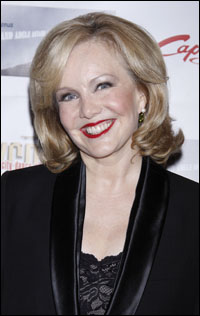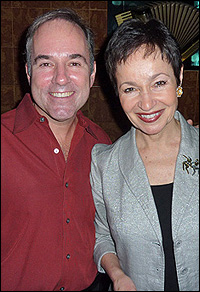
When Sylvester Stallone first asked Thomas Meehan if he'd write a Broadway musical of "Rocky," he said no. Meehan essentially wrote the book on writing the book for films turned into musicals — he scripted Broadway's version of The Producers, Hairspray, Cry-Baby, Young Frankenstein and Elf — but he feared that "Rocky" was too iconic, still seared in the memories of most Americans.
"Then Sylvester brought me to his house on a mesa at the top of Beverly Hills and we watched 'Rocky' together," he said, "and it reminded me how well the story was constructed, how much it was already like a play. So I said yes."
Making movies into musicals is nothing new for Broadway — since My Favorite Year in 1992, nearly every season has had one. Just as Hollywood seems increasingly in thrall to superheroes and young adult novels, Broadway is turning with increasing frequency to Hollywood for stories with recognizable brands. This season brings not only Rocky but Bullets Over Broadway and The Bridges of Madison County (technically an adaptation of the best-selling novel). Not to mention the forthcoming Aladdin, from the Disney movie musical, and Ever After, from the 1998 Drew Barrymore film.
"It's very tricky," said Marsha Norman, who wrote the Bridges book, when it comes to figuring out what stays, what goes, and where to put the songs. This year's trio of iconic movies-into-musicals all feature experienced hands: Norman (The Color Purple), Bullets director and choreographer Susan Stroman, (The Producers, Young Frankenstein, Big Fish) and Meehan, who brought in Stephen Flaherty and Lynn Ahrens (My Favorite Year, Ragtime) to write the score.
"The process is similar in that you start with the screenplay and figure out how to re-structure it into a musical," Stroman said. For starters, movie screenplays build over three acts while plays have two, "and you need a cliffhanger so people come back after intermission." Additionally a movie may have 80 locations while a show cuts that down to eight or ten. "Then you have to decide which scenes to keep and how to incorporate them," she said. "Then you have to identify where the songs [go]."
With Mel Brooks, she would say, "I need you to write a song here called 'Break a Leg,'" but Woody Allen is using classic period tunes "so we had to sit and go through the American songbook and find songs that could push the plot forward."
Meehan said sometimes Flaherty and Ahrens would ask if they could take one of his scenes and make it into a song, using his dialogue as lyrics.
| |
 |
|
| Susan Stroman | ||
| Photo by Joseph Marzullo/WENN |
Certain storylines have to be simplified. "Woody [Allen] had to lose a few of the gangsters he loved," Stroman said, while others were added. "I invented new characters and new scenes," said Meehan, adding that his early days writing parodies for The New Yorker of everything from James Joyce to "Jonathan Livingston Seagull" has enabled him to capture the voices of Mel Brooks (for whom he also wrote in television and movies), John Waters and now Stallone. (Next up for Meehan is an adaptation of Preston Sturges' "The Lady Eve.")
Norman said her favorite part of Bridges has been expanding the viewpoint to include the remote father, quarreling teenagers and a secondary couple in the model of Fred and Ethel Mertz, who "give the viewpoint of the community looking in, raising the question of how you live your own life with everyone watching you."
Everyone emphasized that movies don't translate straightforwardly to the stage because they speak different languages. "I remember in the movie of 'Bridges' there's an incredible moment when Meryl Streep is in the truck seeing Clint Eastwood in the rain through the windshield wipers," Norman said. The theatre can't recreate that, but "what the movie lacked — and what only a musical can do — is let people sing the size of their emotional life. The real power of music is that it fills you up and expresses what's inside you."
Flaherty said the music replaces the movie close-up. "I wrote a song for Adrian that goes beyond the movie — it's about what she doesn't say, it's her interior life," he said, adding that even in the musical's climactic fight scene, the team wrote songs so the audience hears what the titular character is enduring. "Rocky" presents several challenges that go beyond the typical screen-to-stage adaptation. For starters, so many scenes are part of our collective pop culture landscape. When Flaherty first saw the movie, "my best friend and I came home and started pounding ground meat in my mother's kitchen." That famous meat-punching scene is about to be parodied in Stallone's latest movie, "Grudge Match."
Additionally many of the most memorable scenes are actually intimate moments more suited to an Off-Broadway play. Meehan insisted on sticking with those scenes. "It's a big musical with a huge set and cast and millions being spent but there's a row of them in Act I that last 15 minutes," he said referring to the Thanksgiving scene, Rocky and Adrian ice skating and their first time alone in his apartment.
| |
 |
|
| Stephen Flaherty and Lynn Ahrens |
Then there was Bill Conti's soundtrack, still unforgettable nearly four decades later.
Meehan — who had persuaded Stallone to forgo Hollywood tunesmiths for Flaherty and Ahrens — insisted the show have an original score... and include Conti's music.
"The music is part of the movie's DNA," Flaherty said. "To deny it exists would be crazy. I had to find ways to weave it in and out of my score, to embrace it yet to stay ahead of the audience. Sometimes I disguise it, sometimes it's just in the rhythm or in a harmonic progression — it is there but I use it surprising ways."
Yet Flaherty said, "Rocky is in an odd way my most personal score ever." As a teen, he was struck by how much Stallone's characters were like the people in his working-class Pittsburgh neighborhood, so "I wrote this imagining my neighbors watching it and any time I felt the writing getting too fancy I'd crumple up the paper. I wanted a gritty urban score."
Flaherty said after he and Ahrens wrote the first four songs, they journeyed to Philadelphia where Stallone was filming "Rocky Balboa" to see what he thought. "Lynn sang Adrian's part, but I'm 5-foot-4 and I didn't have the guts to sing the part of Rocky for Rocky himself, so I brought an actor along," Flaherty said.
They started with the defining number, "Fight From the Heart," and when they finished Stallone slammed his fist down hard on the table.
"I didn't know why he did it at first," Flaherty recalled. "Then he said, 'That's it. You've nailed it.'"









